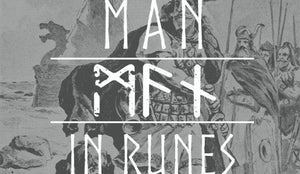This article will be a little different from the ones you will typically find on this site. Not because it is more Christian in focus, but because it may not have a specific message that I can really hone in. Essentially, I stumbled upon something that I thought was kind of cool, really cool actually, and I wanted to share it with the larger community of men, and Wolf and Iron is the place where that happens.
Man in Runes
I was doing a bit of research into the origin of my last name — Yarbrough — and came across evidence that it may have Viking origins. This, of course, caused my bad-ass-o-meter to temporarily spike which led me down the following path. I started looking into Viking things such as runes, the ancient alphabet used by Germanic peoples prior to the Latin influence. Let me say at the outset, I am not a scholar on runes and would love to have any feedback on this article by someone who is.
I think every man would agree that runes simply look cool even if we don’t know what they are all about. I decided to check out an English to Rune converter like this one here. Being all about manliness and whatnot I decided to see what the word “MAN” would look like in runes. The image below shows what it came up with.

MAN in a letter for letter translation in runes. Note that each rune symbol represents a letter of the alphabet but also has a meaning.
Doing a letter-for-letter conversion we have three interesting symbols. I was surprised to see the rune letter “M” (Mannaz) was so close to the English “M”. I was also interested in the “N” which looked to me like a cross. Seeing that it meant “Need” I did a little more digging. Apparently this Naudiz represents a particular type of need. One source said that it was like standing at the edge of a great chasm which you need to cross. Not only is there the need to get to the other side, but you need “something” to provide a way to get across.
I imagine, for the Christians, or just smart folks reading this, you have already caught on to where I ended up. Allow me to continue all the same. The “A” symbol, Ansuz, represents a god, typically Odin but it could be any of the Æsir gods (see this wiki for more information). Whether or not this could be, or ever was, applied to the Christian God is unclear. If you have studied C.S. Lewis you may know something of his stance on the Norse gods. In general — and I am overly simplifying his stance — he felt that Norse pagan worship was something of a pre-cursor to Christianity. Or rather, that Christianity fulfilled the longings which the Germanic people had, and which they tried to address through beliefs in false gods. In other words, they were wrong, but they didn’t have it completely wrong. I’m not saying I agree with him, but it did lead me down another path. Did the Nordics use runes after they became Christians? The answer appears to be, yes.
According to a few online sources, but this one in particular, Norsemen would use the common runes on headstones to signify the deceased as a Christian.
Man Needs God
It is amazing how Christianity transforms your worldview. The power of redemption, the power to see light, the missing page seeming to fit in and complete so many stories, never ceases to amaze me. When I see those letters “M A N” in runes I can’t help but think: Man Needs God. It’s right there!
Final Thoughts
C.S. Lewis believed that Christianity fulfilled the longings of pagans. I think there may be some truth to that. Where the medieval Catholic church attempted to remove any pagan influences, we ended up redeeming them instead. The Yuletide is now a Christmas tradition, most of the days of the week are named after a Nordic god, and here I see a bit of God’s plan in these old symbols. Perhaps it’s just wishful thinking, but it doesn’t stop it from being meaningful.
For those of you who think that the “N” is a little too crooked to make anyone but a Christian fanatic think it looks like a cross, well, I guess it depends on your perspective.

I was in church while thinking about this and noticed that when at the foot of a cross, it looks like the Naudiz. I found this image online and was surprised to find it matched the Naudiz font perfectly!

